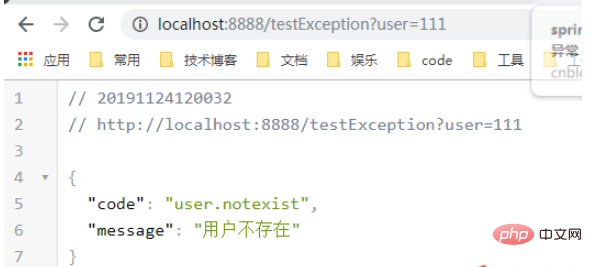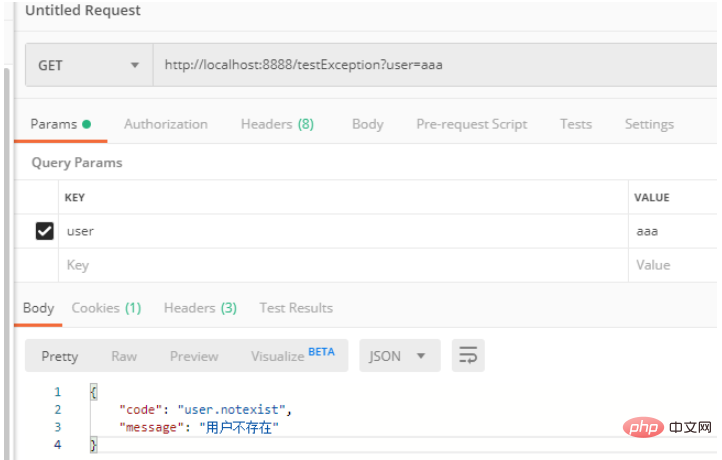Springboot2.0에서 사용자 정의 예외를 처리하고 json을 반환하는 방법
- 王林앞으로
- 2023-05-10 22:19:101460검색
1. 사용자 정의 예외 클래스 작성
package cn.jfjb.crud.exception;
public class UserNotExistException extends RuntimeException {
public UserNotExistException() {
super("用户不存在");
}
}
2. 자체 테스트 예외 처리
package cn.jfjb.crud.handler;
import cn.jfjb.crud.exception.UserNotExistException;
import org.springframework.web.bind.annotation.ControllerAdvice;
import org.springframework.web.bind.annotation.ExceptionHandler;
import org.springframework.web.bind.annotation.ResponseBody;
import java.util.HashMap;
import java.util.Map;
@ControllerAdvice
public class MyExceptionHandler {
@ResponseBody
@ExceptionHandler(UserNotExistException.class)
public Map<string> handleException(Exception e) {
Map<string> map = new HashMap();
map.put("code", "user.notexist");
map.put("message", e.getMessage());
return map;
}
}</string></string>
3 application.yml 파일을 구성합니다(구성 없이는 예외를 얻을 수 없음)
server: error: include-exception: true
4. 테스트 작성
package cn.jfjb.crud.controller;
import cn.jfjb.crud.exception.UserNotExistException;
import org.springframework.stereotype.Controller;
import org.springframework.web.bind.annotation.RequestMapping;
import org.springframework.web.bind.annotation.RequestParam;
@Controller
public class HelloController {
@RequestMapping({"/testException"})
public String testException(@RequestParam("user") String user) {
if (user != "aaa") {
throw new UserNotExistException();
}
return "index";
}
}


위 내용은 Springboot2.0에서 사용자 정의 예외를 처리하고 json을 반환하는 방법의 상세 내용입니다. 자세한 내용은 PHP 중국어 웹사이트의 기타 관련 기사를 참조하세요!
성명:
이 기사는 yisu.com에서 복제됩니다. 침해가 있는 경우 admin@php.cn으로 문의하시기 바랍니다. 삭제

